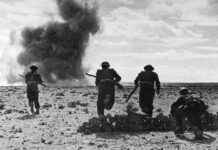Across the field, wisps of smoke mark where the strike hit the Russians, in a flat, deserted landscape. A drone hovering somewhere on the horizon as the sun sets sends images that suggest two Russians have been killed.
The news is welcomed by the Ukrainian soldiers who quickly drove their huge howitzer into open ground.
But the heavy fire throughout this day which is coming to an end threatens to intensify at sunset and the men withdraw into what remains of a school.
Two paramedics stationed with their unit exchange knowing glances and step back into the protective ruins of a nearby gymnasium.
“They don’t let us forget that they are still there,” observes Andriï, 24, a welder before the war.
“It can go wrong there,” adds his comrade Oleskiï, barely older.
They hide their full identities for military security reasons, like everyone who serves in the Ukrainian Armed Forces.
“But we know that they suffer much more on their side than on ours”, adds Oleksiï with a hint of a smile.
Troop morale could prove vital as Ukraine attempts to maintain the enthusiasm for the northern counter-offensive in the treacherous southern steppes.
The ultimate goal is Kherson, a key city for access between Crimea, annexed by Russia since 2014, and the shore of the Sea of Azov.
– Six weeks –
Kerson, which had some 288,000 pre-war inhabitants, was the first major town taken by Russian forces at the start of their offensive launched on February 24.
The Russian occupation administration has sworn to make it a “fortress” to resist the Ukrainian offensive in this region, which the Kremlin claims should be annexed.
Ukrainians have about six weeks before winter frosts hamper any further advance. But the Russians are hanging on.
According to an adviser to Ukrainian President Volodymyr Zelensky, Moscow has sent new reinforcements and currently has thirty tactical battalions around Kherson.
Each of these well-equipped units has up to 800 soldiers and controls a specific part of the front.
“It’s a huge military force that will be difficult to break,” presidential adviser Oleksiy Arestovitch warned this week.
Artillery combat in the areas just north of Kherson is fought by tanks and other heavy guns over open terrain where little more than ruins remain.
Kobzartsi is one of the many localities that appear on the map of Ukraine but which now practically no longer exist.
Its two main streets are lined with the skeletons of rural houses and heaps of rubble where buildings once stood.
According to the soldiers, a few dozen inhabitants are still hiding in their cellars. Few venture outside much, because of the bombardments but also of the unexploded devices which strew the roads and the vegetable gardens.
“They hide almost all the time,” notes paramedic Oleksii. “We try to help them and sometimes volunteers deliver supplies. But we can’t do much more.”
The commander of the artillery unit is a weather-beaten, 47-year-old man who goes by the nom de guerre “Anaconda”. He named his dog “Javelina”, in reference to the American Javelin anti-charge missiles which played a crucial role in repelling the Russian assault on kyiv during the first month of the war.
Anaconda admits he didn’t really know how to use any modern weapon when he was drafted and quit his job in customs when the Russians invaded.
“You feel bad if you shoot and miss. You really blame yourself,” he said with a self-deprecating laugh. “But we really try to do our best.”
“We are learning as we go. We are improving day by day.”








